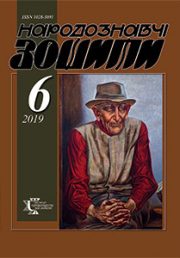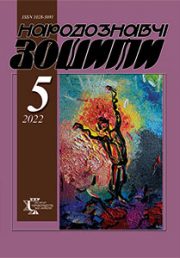The Ethnology Notebooks. 2021. № 6 (162), 1483—1506
UDK [39:692.2](477.4/.5)”18/19″:930.2
DOI https://doi.org/10.15407/nz2021.06.1483
RADOVYCH Roman
- ORCID ID: http://orcid.org/0000-0002-1900-8948
- Doctor of Sciences in History, Senior Researcher
- of the Institute of Ethnology
- of the National Academy of Sciences of Ukraine,
- in the Department of Historical Ethnology,
- Svobody Avenue 15, 79000,
- Lviv, Ukraine
- Contacts: e-mail: radovychroman@gmail.com
Abstract. A number of issues concerning construction techniques and technologies have remained out of their attention, although the traditional housing of the Middle Dnieper region has repeatedly been the subject of research by scientists. In fact, this determines the relevance of our investigation. In the article the author aims to clarify the features of technique and technology of traditional housing in Zolotonosha and the left bank of Kaniv districts of Cherkasy region in the context of housing culture of the left bank of the Middle Dnieper. The object of research is folk housing, and the subject — the technique and technology of wall construction. The methodological basis of the study is the principle of historicism in combination with elements of structural and functional analysis and the use of basic methods of ethnological science: retrospective, typological, complex and analysis, historical reconstruction etc. The investigation area covers Zolotonosha and the left bank of Kaniv districts of Cherkasy region. Chronological boundaries of the study: the end of the XIX — first half of the XX century. The source base of the work is the author’s field materials collected in the Zolotonosha (2010) and Kaniv (2009) districts of Cherkasy region. At the same time, a significant array of scientific literature and sources, including field research of modern Ukrainian ethnologists, concerning the folk construction of the left bank of the Middle Dnieper region, is involved to achieve the goal of the study.
In the late nineteenth — first half of the twentieth century in Zolotonosha district, as well as in the Middle Dnieper region in general, there were dwellings of two main constructive types: log houses and frame houses. In the middle of the twentieth century clay buildings («khata-lipka», «toptana khata», «byta khata») and, in some cases, with walls made of adobe also spread here. During this period, log houses were very rare here, mostly as relics of antiquity. The walls of the «chopped houses» were mostly made of pine wood, only the lower crown was made of oak. With regard to frame buildings, they were based on oak pillars dug into the ground («sokhy», «prysokhy», shuly»). On top of them was placed a pinch («oshchip») — a few wreaths tied at the corners in the lock. According to the material and method of filling the frame of the walls in Zolotonosha, a distinction was made between a «wooden house» («dereviana khata») and a «mazanka-khata» («mazka»). There were two ways to fill the walls of a «wooden house» with wood: vertically and horizontally. «Khata-mazanka» was called frame houses made of firewood («khata z lisy») or reeds («kulachtna khata»), coated on both sides with clay. The «reed house» («ocheretiana khata») to some extent existed in almost all of the settlements we examined, while the houses made of firewood occurred sporadically (mostly as relics of antiquity).
Keywords: Middle Dnieper region, Zolotonosha district, housing, construction equipment, log house, frame.
Received 14.07.2021
REFERENCES
- Rusov, M.A. (1902). Settlements and buildings of peasants in the Poltava province. Collection of the Kharkov Historical and Philological Society (Vol. 13). Kharkov: Pechatnoe Dilo [іn Russian].
- Kovalenko, G. (1912). About Ukrainian style and Ukrainian house. Ukrainian house (Pp. 166—201, 272—282). Kyiv [іn Ukrainian].
- Svyryda, R. (2013). Monuments of folk construction of the forest-steppe Kyiv region and the National Museum of Folk Architecture and Life. Problems of preservation, reproduction and popularization of historical and cultural heritage in the context of open-air museums (Vol. 1, pp. 252—262). Lviv: Apriori [іn Ukrainian].
- Myloradovych, V. (1991). The life-being of a Luben peasant. Ukrainians: popular beliefs, belief, demonology (Pp. 170—341). Kyiv: Lybid [in Russian].
- Padalka, L.V. (1906). What did the population of the Poltava province say about their old life. Proceedings of the Poltava Scientific Archive Commission (Issue 2, pp. 22—29). Poltava [іn Russian].
- Markovich, J. (1798). Notes on Malorossiya, its inhabitants and products (Part 1). SPb.: under the Provincial Board [іn Russian].
- Shafonsky, A. (1851). Chernigov governorship topographic description with a brief geographical and historical description of Little Russia from parts of which this governorship is composed. Kiev: In the University Printing House [іn Russian].
- (1858). Life of the Malorussian peasant (Mostly in the Poltava province). Ethnographic collection (Pp. 19—46). St. Petersburg [іn Russian].
- Ivanitsa, A. (1853). Household life of Maloros, Poltava province, Khorolsk district. Ethnographic collection published by the Imperial Russian Geographic Society (Issue 1, pp. 337—371). SPb.: In the printing house of Eduard Prats [іn Russian].
- Zelenin, D.K. (1916). Description of the manuscripts of the scientific archive of the Imperial Russian Geographical Society (Issue 3, pp. 989—1279). Petrograd: Printing house A.V. Orlov [іn Russian].
- Rusov, A.A. (1899). Description of the Chernigov province (Vol. 2). Chernigov: Printing House of the Provincial Zemstvo [іn Russian].
- Skrypnyk, H. (Ed.). (2020). Ethnographic image of modern Ukraine. Corpus of expeditionary folklore and ethnographic materials (Vol. 9). Folk housing culture. Ecology and habitat organization. Kyiv: IMFE them. M.T. Rylsky [іn Ukrainian].
- Svyryda, R. (2009). Traditions of folk building. Shevchenko region (Pp. 350—363). Kyiv [іn Ukrainian].
- Blomkvist, E.E. (1956). Peasant buildings of Russians, Ukrainians and Belorussians: (settlements, dwellings and economic structures). East Slavic ethnographic collection: Essays on folk material culture of Russians, Ukrainians and Belarusians in the 19 — early 20 centuries (Pp. 3—458). Moscow: Publishing House of the Academy of Sciences of the USSR [іn Russian].
- Chubнnsky, P.P. (1877). Russians of the South-Western Territory: housing, utensils, farm buildings and tools. Proceedings of the ethnographic and statistical expedition to the West Russian Region, equipped with the Russian Geographical Society of the South-West Division (Vol. 7, issue 2, pp. 339—606). SPb. [іn Russian].
- Kosmina, T.V. (1986). Traditions and innovations in the architecture of the people’s of Kyiv and Kyiv region. Ethnography of Kyiv and Kyiv Region: Traditions and Modernity (Pp. 157—200). Kyiv: Naukova dumka [in Ukrainian].
- Kosmyna, T. (1999). Settlement, mansion, housing in Ukrainian: historical and ethnographic monography in two books (Vol. 2, pp. 13—57). Opishne: Ukrainian Genre Studies [іn Ukrainian].
- Chizhikova, L.N. (1988). Russian-Ukrainian border guards: history and destinies of traditional everyday culture. Moscow: Nauka [In Russian].
- Radovych, R. (2017). Polissya dwelling: cultural and genetic origins and evolutionary processes. Lviv [іn Ukrainian].
- Hurkov, V.S., & Hoshko, R.Y. (1988). Settlements. Polesie. Material culture (Pp. 279—333). Kiev: Scientific Opinion [іn Russian].
- Moszynski, K. (1929). Folk culture of the Slavs (Part 1: Material culture). Krakow [іn Polish].
- Vovk, F. (1995).Ethnographic features of the Ukrainian people. In Vovk F. Studies on Ukrainian ethnography and anthropology (Pp. 39—218). Kyiv: Art [іn Ukrainian].
- Krymsky, A. (1930). Zvenigorod region. Shevchenko’s homeland from the ethnographic and dialectological point of view (Part 1, issue 1). Kyiv [іn Ukrainian].
- Radovych, R. (2010). Traditional housing of Ukrainians in the southern part of Podillya in the second half of the 19th — beginning of the 20th centuries: structural and technological aspect (based on materials of the Khmelnytsky region). Bulletin of the University of Lviv. Historical Series (Vol. 45, pp. 437—462). Lviv: Lviv National University I. Franko [іn Ukrainian].
- Radovych, R. (1996). Rural housing of the late 19 — early 20 centuries in the south of Podillya (based on materials from Borshchiv district). Chronicle of Borshchivschyna: Historical and Local Studies Collection (Issue VІІІ, pp. 58—66). Borschiv: Source [іn Ukrainian].
- Radovych, R. (1995). Traditional rural housing in Opillia in the second half of the 19 — early 20 centuries. The Notes of the NTSh (Vol. 230, pp. 79—106). Lviv: NTSh [іn Ukrainian].
- Radovych, R. (2020). Traditional dwelling in Bukovynian Podillya at the second half of the 19th — early 20th centuries (based on materials from Khotyn district, Chernivtsi region). The Ethnology Notebooks, 2, 277—292 [in Ukrainian].
- Gloger, Z. (1907). Timber construction and wood products in old Poland (Vol. 1). Warsaw: Print. W. Lazarski [іn Polish].
- (1788). Topographic description of the Kharkiv Viceroyalty with historical notice about the changes that have hit this country since ancient times. Moscow [іn Russian].
- Taranushenko, S.A. (2012). House on Yelisavetinsky Ave. under Part 35 in Kharkiv. In S.A. Taranushenko Scientific heritage. Kharkiv period. Research of 1918—1932 (Pp. 21—48). Kharkiv: Publisher Savchuk O.O. [in Ukrainian].
- (1873). Materials for the study of the Podolsk province in statistical and economic relations. Kamenets-Podolsk: Printing house of the Provincial Administration [in Russian].
- Fundukley, I. (1852). Statistical description of the Kiev province (Part 1). SPb.: In printing houses of the Ministry of Internal Affairs [in Russian].
- Mohylchenko, M. (1899). A building in Chernihiv region, Hlukhiv district in the village of Poloshkah. Materials on Ukrainian-Rus ethnology (Vol. 7, pp. 79—95). Lviv: from the NTSh printing house [in Ukrainian].
- Rusanova, I.P. (1973). Slavic antiquities of the 6th—9th centuries between the Dnieper and the Western Bug. Archeology of the USSR: SAI (Issue Е1-252). Moscow: Science [in Russian].
- Petrashenko, V.O. (2005). Architecture of settlements in Slavic and ancient times VIII—XIII centuries. In Videiko M.Yu., Terpylovsky R.V., Petrashenko V.O. Ancient settlements of Ukraine (Pp. 115—160). Kyiv [in Ukrainian].
- Sveshnikov, I.K. (1971). Culture of lace ceramics of the western part of the USSR. Stzhizhov culture. Archeology of the Ukrainian SSR: in 3 vol. (Vol. 1, pp. 292—308). Kyiv: Naukova dumka [in Ukrainian].
- Babenko, V.A. (2013). Ethnographic sketch of the folk life of the Yekaterinoslav region. Kharkov: Kharkov Private Museum of the City Estate [in Russian].





